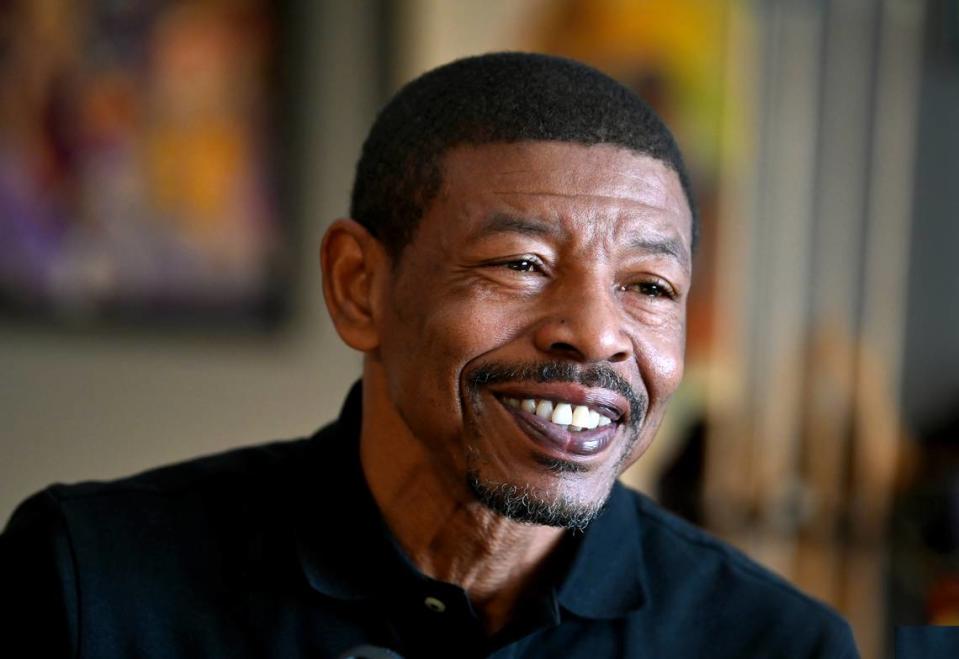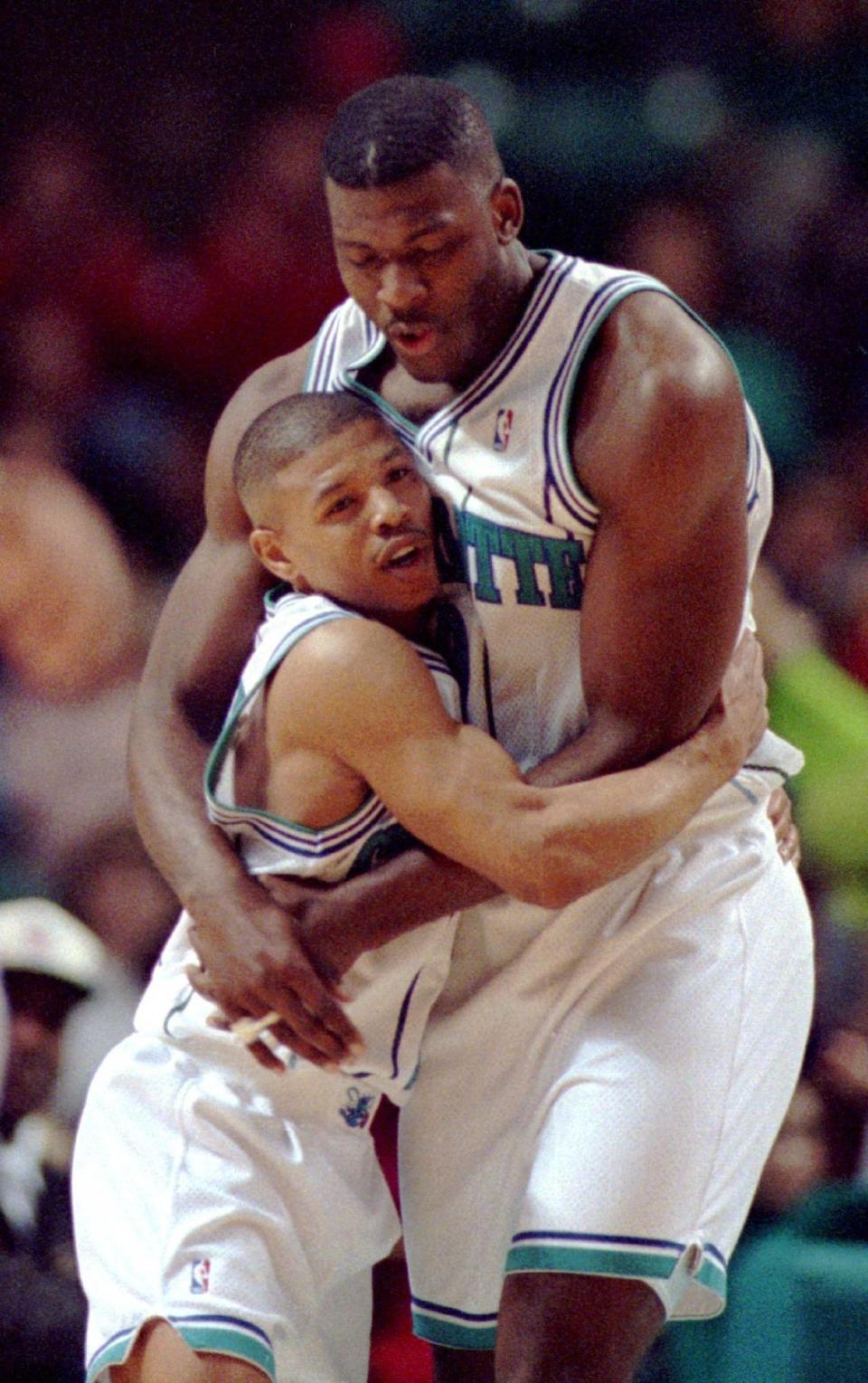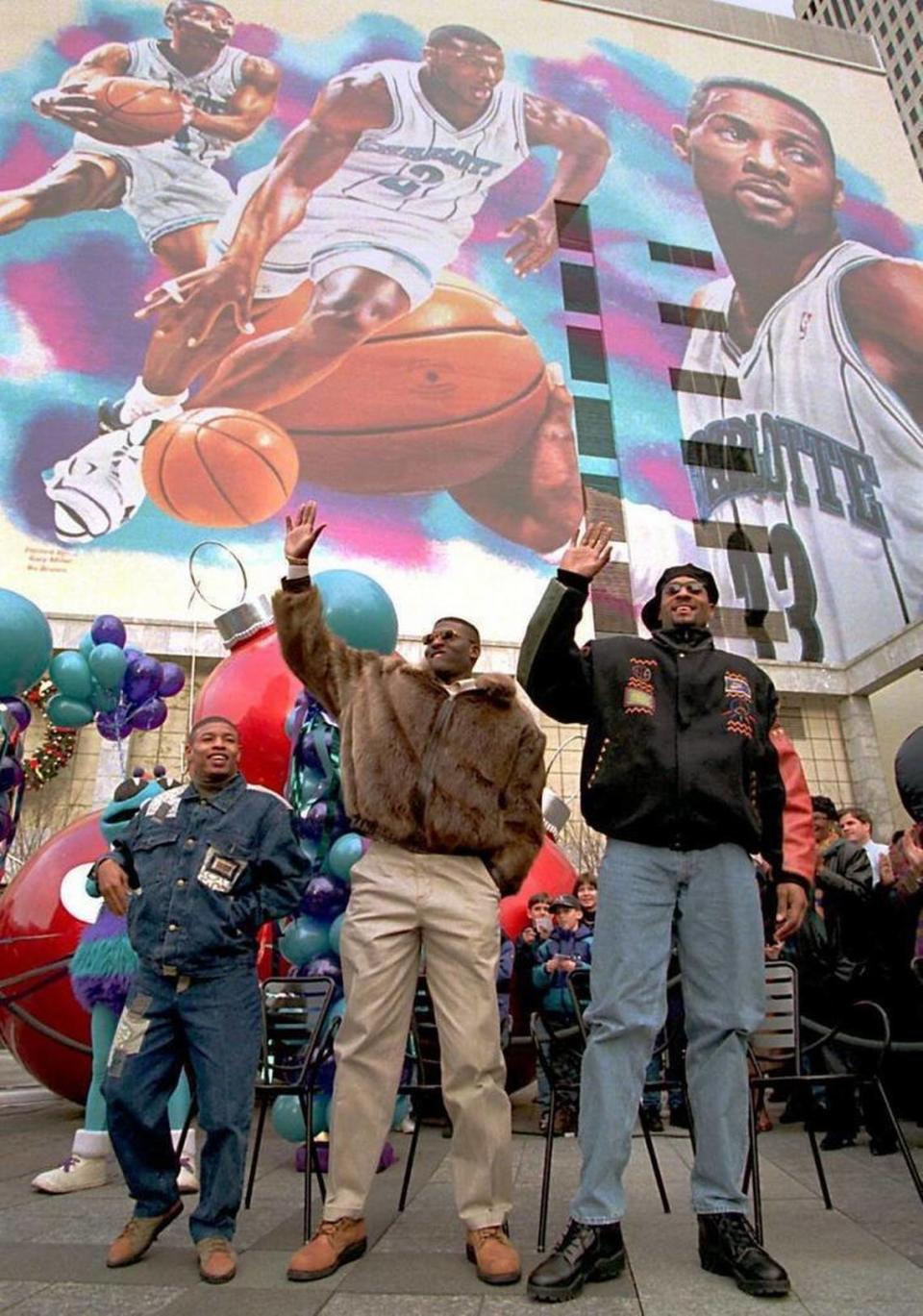Muggsy Bogues kicks off new Charlotte Observer series ‘Sports Legends of the Carolinas’
Charlotte Observer sports columnist Scott Fowler and visual journalist Jeff Siner have spent much of 2022 tracking down sports legends in both North and South Carolina. Then they have done in-person interviews with these iconic sports figures about the remarkable lives they’ve led, the lessons they’ve learned and the stories they’ve never told.
For the next three months, the Observer will publish one of these extraordinary conversations every week — online, in print and in a new podcast called “Sports Legends of the Carolinas” that can be found wherever you get your podcasts (with bonus content available for every episode exclusively on Apple Podcasts).
First up: legendary Charlotte Hornets point guard Muggsy Bogues. He will be followed by NASCAR hall of famer Dale Earnhardt Jr., and after that … well, let’s keep it a surprise from there. Just enjoy the ride with us as we wind through the Carolinas, and hear directly from more than a dozen of the region’s biggest sports stars in “Sports Legends of the Carolinas.”
##
Muggsy Bogues, the first interview subject for The Observer’s new “Sports Legends of the Carolinas” multimedia project, remains the shortest player ever to play in the NBA at 5-feet-3.
Bogues stayed in the NBA for 14 years, most notably as the point guard for the exciting Charlotte Hornets teams of the 1990s that also starred Larry Johnson, Alonzo Mourning and Dell Curry. Before the NBA, Bogues starred at Wake Forest and became the 12th overall pick of the 1987 NBA draft. At age 57, he still lives in the Charlotte area today.
This interview was conducted in his Charlotte home, inside a memorabilia room that was full of keepsakes from Bogues’ career. It has been edited for clarity and brevity.
A fuller version of the interview — where Bogues also discusses former Hornets owner George Shinn, what future NBA MVP Steph Curry was like as a toddler and the time Bogues and Dell Curry suited up for a minor-league baseball team in Gastonia and then actually played in a game — can be found on the new Charlotte Observer podcast “Sports Legends of the Carolinas,” with bonus content available on Apple podcasts.
RELATED: Why we tracked down some of the greatest sports legends in Carolinas history
Scott Fowler: In researching this interview, I came across what I thought was an amazing stat. In the NBA, at 5-foot-3, you blocked 39 shots, and one of them was a shot by 7-foot New York Knicks center Patrick Ewing. So how did that ever happen?
Muggsy Bogues: Well I did have a 44-inch vertical (jump), so I can get up a little bit off the floor. Patrick just happened to put the ball behind his head. He liked to fade away and I just happened to be able to time it perfectly and get my hands on it. And then right after that, I let him know he was gonna be part of my highlight film.
But seriously, out of those 39 blocks, a lot of them came below the waist. You know, as people go up, we knocked the ball down. Sometimes they count it as a steal, and sometimes as a block.
SF: A 44-inch vertical. So could you dunk ever?
MB: Yeah, I was able to dunk the basketball. I just never dunked in a game. I could grab a volleyball and palm it and go up there and dunk it. But for a basketball, I had to time it perfectly, because I couldn’t control it.

SF: You’ve written a book that’s very good and is called “Muggsy: My life from a kid in the projects to the godfather of small ball.” What prompted you to write it?
MB: In 1994, I wrote my first book: “In the Land of Giants.” But this time around, it’s more substance. I had a lot more opportunity to kind of live a little. It’s more of a “beyond just basketball” book. ... It’s about someone having a passion and chasing it each and every day, and about relationships. Me and my wife, you know, we rekindled after being divorced for 10 years.
SF: You write evocatively about Baltimore and the housing projects you grew up in. … Tell us how you were shot, literally, at age 5.
MB: A fight had broken out outside our apartment building. One of the boys, a kid, took a rock and broke one of the store owner’s windows. He came running out the store, went straight to his shed and grabbed his double-barrel shotgun, and just started shooting through the neighborhood. … The buckshot hit my leg and went all through my back and my arms, and I still have some in my arm today that’s a reminder. … That was the way we grew up. You had to be looking over your shoulder at any given time.
SF: Your Mom was 4-foot-11 and your Dad was 5-foot-5, so you probably weren’t surprised to end up at 5-3. When did you stop growing?
MB: Oh shucks, I think I stopped growing right around my ninth or 10th-grade year. I was 5-3 from that moment on and I never grew. … My oldest brother, Chuck, was only 5-6 and my middle brother, Anthony, was 5-7 — the tallest in the family. The 5-foot family, as I call us.

SF: That time of your life when you were growing up in Baltimore, that’s where your nickname “Muggsy” came from. I think a lot of people don’t even realize your first name is really Tyrone.
MB: That’s true. My mama named me Tyrone Curtis Bogues, but people just believe that my name is Muggsy. It all came when I was 7 years old, growing up in the city. A lot of kids, when I used to go play on the basketball court, they used to make fun of me because of my size. ... But one day one of the kids had to leave and one of the other kids hollered, “Hey, you little shrimp, you want to play?”
I went over there and played with the bigger kids.
The first time he put the ball on the ground. I stole it from him and laid it up. Second time he did it, I stole it from him again. Then he tried to get a little more aggressive because he thought it was a fluke, and I faked him one way, stole it from him, gave it to my teammate. And then one of this players’ teammates hollered: “Man, this kid is out here mugging you! He’s just mugging you each and every time you put the ball on the floor!”
SF: You played on one of the greatest high school teams of all time — the Dunbar Poets in Baltimore, who in the 1980s had three first-round NBA draft picks on the roster in yourself, Reggie Williams and Reggie Lewis, as well as another longtime NBA player in David Wingate.
MB: Not only that, but we had 15 kids get Division I scholarships.
SF: With all that talent, how heavily recruited were you?
MB: A lot of college coaches used to come and watch our practice, as opposed to going to the games, because we would blow everybody out. So they felt like it was more competitive, watching us compete in practice. And I always felt like if they come in watching somebody else, I want to make sure they talk about me later.
I had the likes of Seton Hall, Virginia, Boston University and Wake Forest, of course. Georgetown just was slightly interested in me but didn’t go real heavy at me. I think I made the right decision by going to Wake Forest.
SF: Washington drafted you in the first round in 1987, but it didn’t really work out that well.
MB: It didn’t, although I’m so thankful Washington drafted me. I was mentored by the late Moses Malone. Moses taught me so much about how to conduct yourself, how to be a pro. And meeting the likes of the late Manute Bol, he became very close to me. Back then the teams didn’t all fly private planes; we used to fly commercial and there would only be eight first-class seats. Manute and I (were) the youngest and so we had to go sit in coach.
And of course he was 7-foot-6. Knees up to his chest. And he’s back there trying to tell me stories about how he killed lions with a spear. We had so much fun. I miss him dearly.

SF: There are some famous pictures of the two of you showing the nearly 2-½ foot difference in height. But you also wrote in your book that you thought Washington occasionally used the two of you as a gimmick.
MB: Yes. I think they started to try to use me and Manute as a novelty act, because of the height differential. But luckily for Manute and I, we were comfortable in our own skin.
SF: You came to Charlotte in the expansion draft. I think every Charlotte Hornets fan wishes they had kept the band together. The glory days really were you on the fast break with maybe Larry Johnson on one side and Alonzo Mourning on the other. What was it like playing in front of 24,000 people, night after night, with that group?
MB: Special. People don’t understand how special that was. Because that (crowd) was truly our sixth man. I mean, they got us through so many games. And having that talent around me made it a lot easier to get up and go to work each and every day. We just had some great players and unbelievable times. We could have done something special if we all would have kept that band together.
But things happened. The ugly head of the NBA showed itself.
SF: The Hornets shouldn’t have traded Zo, right? Is that what you’re referring to?
MB: Yeah, Zo was the first domino. A franchise center was desperately needed, and losing him to Miami was (heartbreaking). And then the next piece was Larry and then, at the very end, it was me. ... We left a lot of alley-oop lobs on the table, as well as a lot of wins.

SF: I had forgotten that you were there when Latrell Sprewell choked (coach) P.J. Carlesimo in Golden State.
MB: Yeah, I had just gotten traded actually…. One day at practice, Spre and I were doing our rapid-fire (passing drill). P.J. was monitoring everybody. … He happened to look at Spre and said, “Spre, put something on the ---- pass to Muggsy!”
So we kept doing our rapid-fire drill. Then he came back and approached him again and said, “Didn’t I say put something on the ---- pass to Muggsy?” And at that point, I’m understanding that it was a lot of stuff building up before I even got there…. They started arguing, and Spre grabbed his neck. It was crazy…. It was shocking.
SF: I’ve seen kids approach you many times over the years, no matter what you’re doing. Do you ever get tired of being Muggsy Bogues?
MB: Well, you know, I think it’s God’s purpose. … I embrace it. I’m thankful someone wants to have a a conversation with me.

SF: Tell me about “Space Jam” — the 1996 movie that gave you your most famous off-the-court role.
MB: I had just had surgery. We had just lost to the Chicago Bulls in the playoffs (in 1995) and my knee wasn’t right…. But they were about to shoot “Space Jam,” and I didn’t know if I could participate. When I got to the (set), they created a situation where I didn’t have to walk. And in some of the scenes, I was pulled on a dolly, with my shoulders (moving) like I was walking. And the time where we had to get up and walk to touch the ball, you can kind of see me really limping.
SF: You do a lot of public speaking. What message do you like to leave people with?
MB: For people to just embrace who they are, and not try to live their life as someone else wants them to. And know what your passion is and, if you have it, chase it, chase it, chase it. Don’t let anyone dictate what you should do and who you should become. We only get one life. … I hope that everybody will just love more than they can hate, and know more than they can judge. Respect each other, love each other, and live life to the fullest.
For much more from this interview and to hear future “Sports Legends” interviews, including a conversation with Dale Earnhardt Jr. next week, subscribe to the “Sports Legends of the Carolinas” podcast. Part 1 is available wherever you get your podcasts. Part 2 you can find only on Apple Podcasts. New episodes will be released every Wednesday.


 Yahoo Movies
Yahoo Movies 